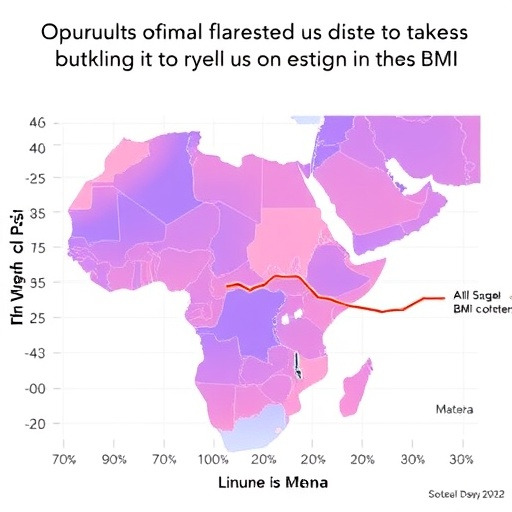In recent decades, the global surge in obesity rates has emerged as one of the most pressing public health challenges worldwide. While Body Mass Index (BMI) has long been a universally adopted metric to assess overweight and obesity, a paradigm shift is underway. Scientists increasingly recognize that the standard BMI cut-offs currently endorsed internationally may not adequately capture the true cardiometabolic risk profiles across diverse ethnic groups. Nowhere is this disparity more glaring than in Arab and Middle Eastern populations, where unique genetic, environmental, and lifestyle factors converge to influence health outcomes differently. A groundbreaking systematic review and meta-analysis published in 2025 seeks to recalibrate BMI thresholds specifically for these populations, offering potentially transformative implications for early intervention and disease prevention.
The study, led by Al Busaidi, Al-Maqbali, Al Nou’mani, and colleagues, delves deep into the complex relationship between BMI values and cardiometabolic morbidity and mortality among Arab and Middle Eastern cohorts. Traditionally, BMI cut-offs devised predominantly based on European or North American population data have been globally applied without sufficient consideration for ethnic variations. However, burgeoning epidemiological evidence suggests that individuals of Middle Eastern descent may experience heightened cardiometabolic risk at lower BMI levels compared to their Western counterparts. This phenomenon underscores the urgent necessity of population-specific benchmarks that more precisely reflect localized risk factors.
Technically, BMI is a simple anthropometric index calculated as weight in kilograms divided by height in meters squared, serving as a surrogate for adiposity. Despite its widespread use, BMI’s limitations include its inability to discern fat distribution and distinguish between lean and fat mass. These caveats become critical when interpreting BMI across different ethnicities with varying body compositions. The meta-analysis conducted synthesizes data from multiple cohorts across the Arab World and Middle Eastern regions, employing rigorous statistical techniques to identify optimal BMI cut-off points that correlate significantly with increased cardiometabolic events such as type 2 diabetes, hypertension, dyslipidemia, and cardiovascular mortality.
The results of the meta-analysis are striking, revealing that the BMI thresholds associated with elevated cardiometabolic risk in Arab and Middle Eastern populations are consistently lower than internationally accepted standards. For instance, whereas a BMI of 30 kg/m² typically defines obesity in global guidelines, the study suggests that risks in these populations become pronounced at BMIs around 27 kg/m². This subtle but significant shift indicates that the standard criteria may underdiagnose individuals at risk, delaying preventive measures and potentially exacerbating morbidity.
Underlying the observed discrepancies are multifaceted factors, including genetic predispositions influencing fat metabolism, culturally specific dietary patterns marked by high caloric and saturated fat intake, and varying levels of physical activity. Moreover, environmental exposures and socioeconomic determinants intrinsic to the region further modulate disease risk and progression. The authors of the study emphasize that these nuanced differences necessitate tailored public health policies and clinical guidelines that reflect local realities rather than relying solely on global consensus cut-offs.
In terms of methodology, the analysis leveraged both cross-sectional and longitudinal studies, integrating millions of individual health records where accessible. Advanced meta-regression techniques were utilized to control for confounding variables such as age, sex, urban versus rural residency, and socioeconomic status. The robustness of the findings was affirmed through sensitivity analyses, subgroup stratifications, and assessment of publication bias, ensuring high confidence in the revised BMI thresholds derived for these ethnic groups.
The implications of adopting population-specific BMI cut-offs extend beyond mere numerical redefinition. Clinicians and public health practitioners stand to benefit by improving early-prediction capabilities for cardiometabolic complications, thereby steering at-risk individuals toward timely lifestyle interventions or pharmacological treatments. From a policy standpoint, targeted screening programs can enhance resource allocation efficiency by focusing on high-risk segments that would otherwise remain undetected under universal standards.
Public health education campaigns also require recalibration, with messaging adapted to contextualize what constitutes healthy weight within these specific ethnic frameworks. This reframing could reduce stigma associated with body size while promoting safer thresholds for medical concern. The study’s findings also invite further research into additional anthropometric indicators such as waist-to-hip ratio, body fat percentage, and visceral fat measurements, which may complement BMI in offering a more comprehensive risk assessment toolbox.
Beyond the academic and clinical spheres, this research has profound societal relevance, particularly as Middle Eastern countries continue to face escalating burdens of obesity-related chronic diseases. With many nations in the region undergoing rapid urbanization, shifts towards sedentary lifestyles, and dietary westernization, accurate, population-tailored health metrics become paramount to reverse these trends and improve overall population health.
The systematic review and meta-analysis, published in the International Journal of Obesity, marks a decisive step towards equity in precision medicine and epidemiology. It underscores that “one size fits all” approaches to BMI classification are insufficient and potentially harmful. Indigenous ethnocultural biology must be integrated into diagnostic, preventative, and therapeutic frameworks to optimize health outcomes globally. As the obesity epidemic evolves, so too must our tools and thresholds, embedding sensitivity to ethnic and environmental diversity within foundational health metrics.
Future directions articulated by the researchers underscore the need for large-scale prospective cohort studies within Arab and Middle Eastern countries that incorporate genetic data, lifestyle factors, and socioeconomic variables. Such data will refine our understanding of the interplay between BMI and cardiometabolic health in these populations. Moreover, integration with digital health technologies and AI-driven predictive models could revolutionize personalized health monitoring, enabling dynamic risk stratification tailored to individual ethnic backgrounds.
In summary, this pioneering study challenges longstanding conventions and advocates for a scientifically substantiated revision of BMI cut-offs for Arab and Middle Eastern populations. Its findings have the potential to transform clinical practice guidelines, public health strategies, and individual health trajectories by recognizing and responding to unique cardiometabolic risk profiles. The journey from global uniformity to ethnically informed precision medicine promises to enhance not only life expectancy but also quality of life for millions in this region.
As the world grapples with obesity’s relentless rise, this research exemplifies the critical need to blend epidemiology with ethnographic nuance—only then can we hope to stem the tide of cardiometabolic diseases globally. The recalibration of BMI cut-offs, though seemingly technical, is a beacon of hope for more just, effective, and culturally contextual healthcare in the 21st century.
Subject of Research: Optimal Body Mass Index (BMI) cut-offs associated with cardiometabolic risk in Arab and Middle Eastern populations.
Article Title: Optimal BMI cut-offs associated with cardiometabolic risks in Arab and Middle Eastern populations: a systematic review and meta-analysis.
Article References:
Al Busaidi, S., Al-Maqbali, J.S., Al Nou’mani, J. et al. Optimal BMI cut-offs associated with cardiometabolic risks in Arab and Middle Eastern populations: a systematic review and meta-analysis. Int J Obes (2025). https://doi.org/10.1038/s41366-025-01922-2
Image Credits: AI Generated
DOI: 25 November 2025





